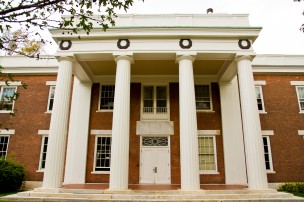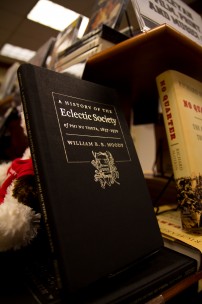
If you have ever pondered the story behind Eclectic, look no further. Sprawled across 211 pages is the history of the University’s one and only Phi Nu Theta, better known in our time as the Eclectic Society.
In his historical account entitled “A History of the Eclectic Society of Phi Nu Theta, 1837-1970,” William B.B. Moody ’59, a former Eclectic member, unearths the society’s history, decade by decade. He offers insight into the genesis of Eclectic and its former objectives and traditions until its transformation in the 1970s.
Bound in black fabric and embossed in gold, Moody’s book was printed by our own Wesleyan University Press. In the densely written text, Moody mentions notable alumni, such as Eclectic founding father Charles Collins ’37; House Representative William P. Hubbard ’63, one of the most beloved Eclectic alumni; and former Wesleyan president Cyrus D. Foss ’54, of Foss Hill fame.
However, Moody’s main focus is tracing Eclectic’s roller-coaster path through history.
This writer was surprised to discover that, during the first century of its existence, Eclectic was strictly a literary and academic society, where top-tier students assembled to hold oral debates and share essays and scholarly criticisms. It was a place to flourish in academia, and amusement was limited to the occasional game of charades or choral rehearsal.
For example, in the 1910s, there were rules limiting raucous behavior: no card playing on Sunday, no gambling, and the strict prohibition of alcoholic beverages.
According to Moody’s book, some hot topics were addressed in Eclectic’s famous literary debates during the 1930s, such as “Resolve that Wesleyan should turn co-ed” and “Maraisana, the Assassin of Youth.” Moody clarifies that “maraisana” is in fact marijuana, and doubts that if Eclectic were to hold that debate today the topic would be concluded in the same fashion.
The society maintained its conservative tradition until the late ’60s, when the Vietnam War and other controversies led Eclectic members to increasingly resist authority and dismiss traditions that previously held the society together.
According to current members, graduated Eclectics became increasingly desperate.
“Alumni had to break into the house in the ’70s and save all the furniture from the Gote room to prevent it from being destroyed, because everyone in the frat was going crazy,” said Eclectic member Charlie Hanna ’12. “They would probably have sold things for drug compensation.”
This and other turbulent events characterized the 1970s demise of the “Old Eclectic.”
But what is the “New Eclectic”? What today characterizes the society that lies behind the giant brick-clad walls on High Street?
To find out, I walked through Eclectic’s historic and iconic white pillars to interview President DonChristian Jones ’12, Vice President Jason Kilbourne ’14, and Hanna.
“Eclectic doesn’t have a mission statement at the moment; it’s up in the air,” Kilbourne said. “We have a lot of appreciation and practice of the arts: visual arts, music, dance. We are definitely not a solely academic society, and there is no longer really heavy intellectual discussion, or at least not a formal practice.”
Even if they don’t have a stated mission, there are many elements that ‘define’ Eclectic. Kilbourne, Hanna, and Jones all agreed that what makes the society so special is the range in talents, skills, interests, race, ethnicity, and sexual orientation found in the society.
“These kids probably wouldn’t have encountered one another and come so close if it wasn’t for this house,” Jones said.
Kilbourne agreed, saying that the diversity of Eclectic was what he valued most.
“It’s a good social environment whether you’re a member or not,” Kilbourne said. “It brings together people from across campus, different types of people. I know a cool cross-section of people through Eclectic.”
Even if the society went through a rebellious phase in the 70s, Eclectics are still extremely dedicated to their society. In particular, they emphasize fostering creativity on campus. For example, they have a strong relationship with Traverse Square, and host after school arts-and-crafts programs.
And, of course, they love to throw parties.
“Eclectic is one of the most valuable resources on campus, because students can potentially throw whatever event they want, for free,” Jones said. “We like having alternatives for the student body if they want to encounter something weird, hopefully, and fun.”
Although Eclectic is no longer the academic society it once was, many of its traditions still hold. Eclectic has always committed itself to being a “consensus society,” and still has a dedicated alumni network with a string of famous graduates, such as the indie rock band MGMT—in case you didn’t already know. They have maintained many traditions as well, such as seniors presenting their theses at the end of the year and meeting in their famous Gote room.
“We still abide by the bylaws,” Hanna said. “They’ve never changed.”




Leave a Reply